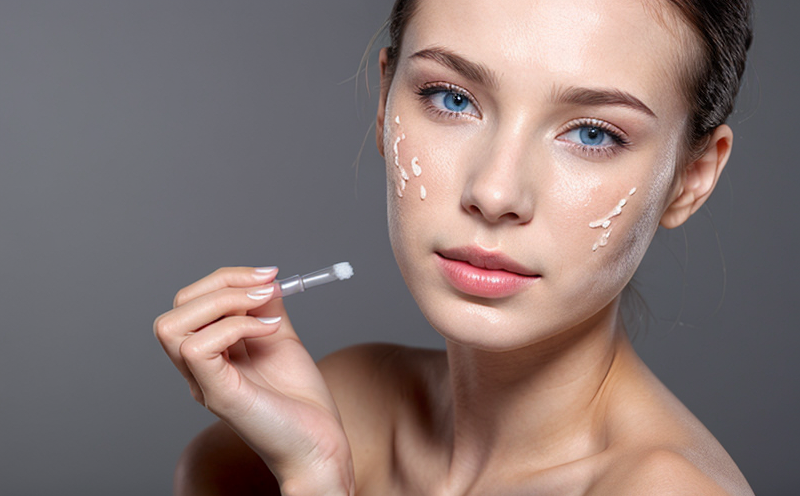Sensitization Testing of Nail Polish Removers
The sensitization testing of nail polish removers is a critical aspect within the cosmetics industry. This process ensures that products do not contain ingredients or components which could potentially cause adverse reactions in consumers, particularly those with sensitive skin. Sensitization refers to the development of an allergic response after repeated exposure to certain chemicals over time. In the case of nail polish removers, the primary concern is whether the remover can trigger contact dermatitis when it comes into prolonged or frequent contact with the skin.
Nail polish removers are typically formulated using solvents such as acetone, ethanol, and other organic compounds that help dissolve the lacquer. These chemicals must be carefully evaluated to determine their potential for causing sensitization. The testing involves exposing human subjects or animal models to the product under controlled conditions, monitoring any signs of irritation or allergic reactions.
Several factors influence the effectiveness of a nail polish remover in terms of its sensitizing properties:
- The concentration and type of solvents used
- Possible presence of additional ingredients like fragrances or dyes that might exacerbate skin sensitivity
- Contact time between the product and the skin
- Application method (e.g., cotton ball, cloth, direct application)
The primary goal is to ensure that users experience safe and effective nail polish removal without risking long-term health issues. Proper testing can help identify any problematic ingredients early in the development process, allowing manufacturers to reformulate their products if necessary.
| Standard Reference | ISO 10993-11:2021 |
|---|---|
| Description of Test Methodology | The test follows a three-stage approach: |
| - Stage one involves initial irritation testing. | |
| - If irritant potential is identified, further steps include assessing sensitization risk using animal models or human patch tests. | |
| - Final stage ensures compliance with all relevant regulations before marketing the product. |
Why It Matters
The importance of sensitization testing cannot be overstated in the cosmetics sector. Regulatory bodies around the world, including those from Europe (EU Cosmetics Regulation) and North America (FDA), have strict guidelines regarding product safety and consumer protection. Companies must demonstrate that their products meet these standards through rigorous laboratory testing.
Failure to comply with these regulations can result in severe consequences such as:
- Bans on the sale of non-compliant products
- Fines levied against offending companies
- Lawsuits filed by affected consumers seeking compensation for damages caused due to use of defective products.
Moreover, from a brand reputation perspective, failing such tests could tarnish a company’s image and lead to lost business opportunities. Therefore, investing in comprehensive sensitization testing is not just about meeting legal requirements but also safeguarding public health while enhancing brand credibility.
Applied Standards
| Standard Reference | ISO 10993-11:2021 - Biological evaluation of medical devices - Part 11: Contact allergens in cosmetics and personal care products. |
|---|---|
| Description of Test Methodology | The test follows a multi-step procedure: |
| - Stage one assesses the irritating potential of nail polish remover by applying it to rabbit ear skin for 48 hours. If irritation is observed, sensitization testing proceeds. | |
| - In case no irritation is noted in stage one, human patch tests are conducted where volunteers apply the product to their backs and observe for any adverse reactions over several days. | |
| - The final step involves statistical analysis of results from both stages to determine if there's a significant risk of sensitization. |
These tests ensure that potential allergens are identified early, allowing manufacturers to make informed decisions about ingredient selection and formulation adjustments. Compliance with international standards like ISO 10993-11 helps cosmetic brands establish trust with consumers and regulators alike.
Competitive Advantage and Market Impact
- By conducting thorough sensitization testing, companies position themselves ahead of competitors by offering safer alternatives to consumers.
- This proactive approach can attract more customers who prioritize personal health and safety when choosing beauty products.
- It also facilitates easier compliance with changing regulations across different markets worldwide.
- Moreover, successful completion of these tests enhances a brand’s reputation among industry professionals and potential investors seeking socially responsible businesses.
In today's competitive global market, where consumer awareness about product safety is increasing, being able to prove that your nail polish remover passes stringent sensitization tests provides a strong competitive edge. It demonstrates commitment to quality control and user well-being, which are increasingly valued by modern consumers.





